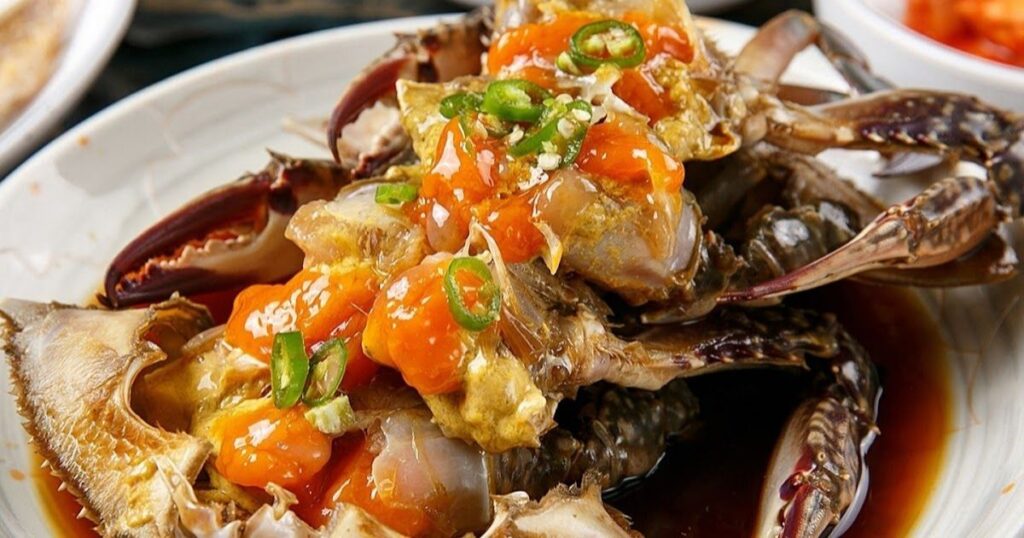Are you ready to embark on a culinary adventure that will tantalize your taste buds and introduce you to one of Korea’s most beloved dishes? Look no further than soy-marinated raw crabs, also known as ganjang-gejang. This traditional Korean crab dish is a true delicacy that combines the salty sweetness of fresh crab with the umami-rich flavors of a soy-based marinade. In this article, we’ll explore the art of preparing this exquisite seafood dish and share some insider tips to help you master the perfect soy crab recipe.
SOY-MARINATED RAW CRABS
Ganjang-gejang, or Korean soy crab, is a dish that perfectly exemplifies Korean cuisine’s intricate flavors and techniques. This marinated raw seafood dish showcases the natural sweetness of fresh crab meat, enhanced by a complex soy sauce marinade that transforms the raw crab into a mouthwatering delicacy.
Gejang, the ultimate rice thief
There’s a popular saying in Korea that ganjang-gejang is the “ultimate rice thief” – and for good reason! The addictive sauce and succulent crab meat will have you reaching for bowl after bowl of steaming rice. The combination of the briny crab flesh and the savory soy marinade creates an irresistible flavor profile that pairs perfectly with plain white rice.
Also read this post: SOY GARLIC
One of the most enjoyable aspects of eating ganjang-gejang is mixing some rice directly into the crab shell, allowing it to soak up all the delicious juices. This simple act transforms each bite into a heavenly experience that showcases why this dish has become such a beloved part of Korean cuisine.
Some tips from the kitchen:

To help you create the perfect soy-marinated raw crabs at home, here are some valuable tips:
- Choose the right crab: For those in the mid-Atlantic region, live blue crabs are ideal. Alternatively, flower crabs work well too. Female crabs are preferred for their meatier flesh and flavorful roe.
- Seek help if needed: If you’re new to preparing live crabs, don’t hesitate to ask your fishmonger to break them down for you. Just mention that you’re making raw marinated crabs.
- Preserve the good stuff: While cleaning the crabs, be sure to remove the inedible innards but keep the mustard (tomalley) and roe. These yellow and orange parts add richness and depth to the dish.
- Invest in quality tools: A good pair of kitchen shears is essential for breaking down the crabs efficiently and safely.
- Monitor marination time: The longer the crabs sit in the brine, the saltier they become. Aim for 1-2 days of marination, then remove them from the brine. Save some of the marinade to drizzle over your rice for extra flavor.
Ingredients

To create this Korean marinated crab dish, you’ll need:
- 5 to 6 fresh live blue crabs (female preferred)
- 1 medium onion
- 1 Fuji apple
- 5 garlic cloves
- 1-inch knob of ginger
- 1 jalapeño pepper
- 2 pieces (2×4 inches) of dried kelp (Kashima)
- 2 cups soy sauce
- 1/2 cup mirin or rice wine
- 1/4 cup sugar
- 6 cups water
Instructions

Follow these steps to prepare your soy-marinated raw crabs:
- Freeze the live blue crabs for at least 2 hours. This humane method puts them to sleep and makes handling easier.
- Prepare the marinade by combining onions, apples, garlic, ginger, jalapeños, dried kelp, soy sauce, mirin, sugar, and water in a pot. Bring to a boil, then simmer for 30 minutes. Strain and cool to room temperature.
- Clean the crabs by removing the apron, separating the shell from the abdomen, cutting off eyes and antennae, and trimming any sharp edges. Optionally, remove the leg tips to help the brine penetrate.
- Scrub the crabs thoroughly and remove inedible innards, keeping the roe and tomalley.
- Place the cleaned crabs in a sterilized container and pour the cooled brine over them, ensuring they’re fully submerged.
- Refrigerate for at least 24 hours before serving with hot rice.
By following these instructions, you’ll create a delicious soy crab recipe that rivals any traditional Korean crab dish you might find in a restaurant. The fermented soy sauce flavor will penetrate the crab meat, creating a harmonious blend of tastes that exemplifies the best of Korean cuisine.
In conclusion, soy-marinated raw crabs, or ganjang-gejang, offer a unique and unforgettable culinary experience. This seafood in soy sauce dish not only showcases the natural flavors of fresh crab but also demonstrates the artful use of fermentation and marination techniques in Korean cooking. Whether you’re a seasoned food enthusiast or new to Korean cuisine, this soy-based marinade for crabs is sure to impress your palate and leave you craving more. So why not give this Korean crab delicacy a try? Your taste buds will thank you!
FAQs
Is it safe to eat soy sauce-marinated raw crab?
Soy-marinated raw crab, or ganjang-gejang, is generally safe to eat when prepared properly. The salt in the soy sauce marinade helps to denature proteins and inhibit bacterial growth while freezing the crabs before preparation further ensuring food safety.
Can Muslims eat marinated crab?
Crab is considered halal in most Islamic schools of thought, so Muslims can generally eat marinated crab. However, it’s important to ensure that all ingredients used in the marinade, such as the soy sauce and any alcoholic components like mirin, are also halal-certified.
What does soy-marinated raw crab taste like?
Soy-marinated raw crab has a unique flavor profile that combines the sweet, briny taste of fresh crab meat with the savory, umami-rich notes of the soy marinade. The texture is tender and slightly chewy, with a burst of complex flavors that range from salty to subtly sweet.
How to eat soy-marinated crab?
To eat soy-marinated crab, start by removing the crab meat from the shell using your fingers or small utensils, then mix it with a spoonful of rice to absorb the flavorful juices. Many people enjoy sucking the marinade from the crab legs and mixing the roe or tomalley (if present) with rice for an extra burst of flavor.











